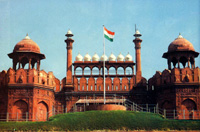| Where the Flag was Raised |
It was from here that Jawaharlal Nehru hoisted the tn-colour on 15th August 1947, as India became a free nation. But the history of the Red Fort goes back a long way before that as well |
|
Red Fort or Lal Qila as it is known is a masterpiece of architecture and one of the most haunting spots for tourists from both India and abroad. Before the mutiny of 1857, the fort presented an altogether different picture from what it presents today because only about one-fourth of the imposing structure is accessible to visitors with the rest of the area being under the control of the Indian Army, which continues the occupation begun after the uprising of 1857 was suppressed. In 1858, a large number of palaces in the fort were demolished, many of the taikhanas (basement rooms) sealed and massive barracks constructed for the soldiers.
|
 |
Before 1857, the fort was a mini-city with palaces, offices, workshops and halls of audience where about 3,000 people lived, yet today more than 10,000 visitors come to savour the magnificence of the building everyday. |
There are 15 distinct structures within the fort with the first being the Lahore Gate and the last one the Moti Masjid. The Lahore Gate of the palace is veiled by the barbican added by Aurangzeb, a Mughal emperor. The gate is from where the Prime Minister addresses the nation and unfruls the National Flag on August 15, Independence Day. |
The entrance of the Gate leads through a long covered bazaar called the Chatta Chowk. From Chatta Chowk follows the Naqqar Khana(Drum Room) also called Naubat Khana or the Welcome Room, which earlier formed part of a square enclosure with apartments for the umrah (Nobles) on duty. It was at this point that everyone other than the Emperor had to dismount from their elephants and walk towards the magnificent Diwan-e-Am(hall of public audience) where the Emperor used to listen to the grievances of the common man. |
The Naqqar Khana is 49 feet high with an open arched hall at the top which served as a music gallery from where the strains of music filtered down to welcome the Emperor or to bid him a safe journey. The War Memorial Museum is housed on the first floor. The Diwan-e-Am is built of red sandstone and is set atop an impressive plinth. The southwest and northwest corners of the pavilion are articulated by small chhattris. |
After 1857, an ornamental panel depicting Orpheus was dismantled, but it was restored at Lord Curzon's initiative at the beginning of the 20th century. The Diwan-e-Am was originally gilded with elaborate stucco work. However, today only the shell of the magnificent structure can be seen. Along the eastern wall of the fort and commanding a scenic view of the Yamuna river was spaced out the private realm of the Emperor. The Yamuna in those days flowed past the walls. The remains of the palaces exist today in the form of Mumtaz Mahal, Rang Mahal, Khas Mahal, Diwan-e-Khas, the hammam and the Shah Burj from where originated the Nahar-e-Bishisht (Canal of Paradise) which flowed in a channel through these buildings. |
The Museum of Archaeology, which has artefacts salvaged from the royal palace, is housed in the Mumtaz Mahal. Rang Mahal (Palace of Colours) gets its name from its painted interior. The northern and southern sections were called Sheesh Mahal (Sheesh-mirrors and mahal- palace). Embedded in the ceiling which reflected lights in fascinating multiplicity, were embedded in the ceiling. This, with its basement, was the palace of the royal ladies. Khas Mahal (Emperor's Palace) has special rooms for private worship and for sleeping. It was small and elegant and had a fine marble screen at the north end which carried a motif of the scales of justice which are seen in many miniature paintings of Shahjahan's time. |
A marble balcony, which once projected over the banks of the Yamuna and once the river changed its course it was from this place that the Emperors used to present themselves for public appearance. Perhaps the most elegant part of the fort is the Diwan-e-Khas (hall of private audience) and it is almost like an undetachable part of the history of the Mllghal Empire. In 1739, the hall witnessed Nadir Shah receiving the submission of Emperor Mohammed Shah, and depriving him of his most valuable treasures including the famed Peacock Throne. It was again here in May 1857 thatlndian soldiers declared Bahadur Shah Zafar, the Emperor of Hindustan. The throne was set on a high impressive plinth along the rear wall and its flat ceiling supported by a series of engrailed arches, was gilded in sliver and had some of the finest pietra dura work and paintings. |
Over the corner arches is inscribed the couplet of Firdaus, the poet in Shahjahan's court which when translated from Urdu means: "If there is a paradise on earth, it is here, it is here, it is here". The hammam (bathing area) has three chambers with a fountain in the middle of the one in the centre. It also has pietra dura work on the walls. Shah Burj was a place where the emperors held private conclaves and it is in a secluded point. |
Besides the conclaves, the emperors would also relax in privacy pondering over various issues. Moti Masjid (Pearl Mosque) was a private masjid and was added by the emperor Aurangzeb. The masjid, with three domes in perfect proportion give it a rare look of elegance. To the north of this masjid is the Hayat baksh, a Mughal garden built by Shahjahan. While at the southern and northern ends are the Sawan Bhadon pavilions in the centre of the garden is the grand Zafar Mahal. |
